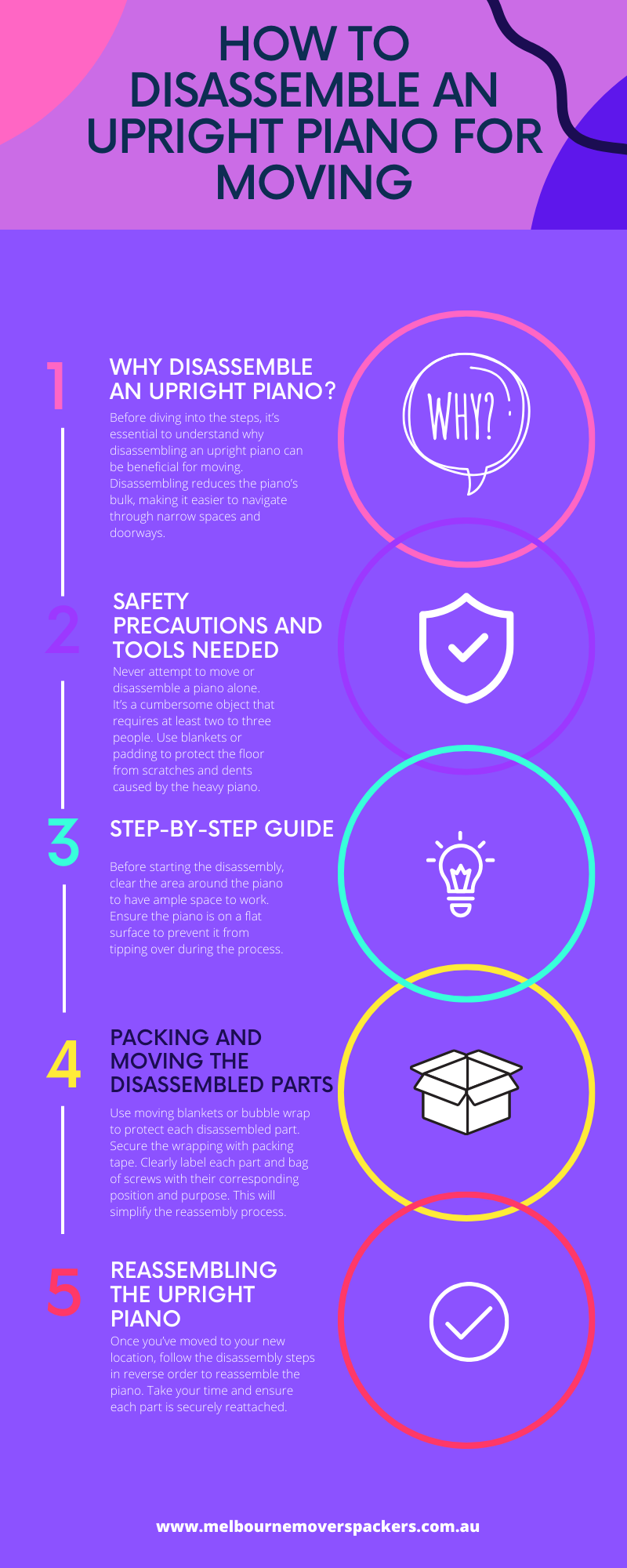Moving an upright piano can be a daunting task due to its size, weight, and delicate components. However, with the right approach, you can disassemble it safely and make the moving process more manageable. In this blog, we will guide you through each step of disassembling an upright, ensuring you handle each part with care and precision. If you’re not confident doing it yourself, professional piano movers Melbourne Australia can make the process seamless and safe
Why Disassemble an Upright Piano?
Before diving into the steps, it’s essential to understand why disassembling an upright piano can be beneficial for moving:
- Easier Handling: Disassembling reduces the piano’s bulk, making it easier to navigate through narrow spaces and doorways.
- Weight Distribution:Removing parts like the lid, legs, and pedals lightens the load, making it easier to carry and reducing the risk of injury.
- Prevention of Damage: Separating delicate components helps prevent damage during transit. For complete peace of mind, movers Melbourne Australia use specialized tools and techniques to move each part safely.
Safety Precautions and Tools Needed
Safety Precautions
- Work in a Team: Never attempt to move or disassemble a piano alone. It’s a cumbersome object that requires at least two to three people.
- Use Proper Lifting Techniques: Bend your knees and keep your back straight while lifting to avoid injuries.
- Protect the Flooring: Use blankets or padding to protect the floor from scratches and dents caused by the heavy piano.
- Wear Protective Gear:Use gloves to protect your hands from sharp edges and heavy components. Hiring experienced movers Melbourne Australia ensures these safety measures are followed professionally.
Step-by-Step Guide to Disassembling an Upright Piano
1. Prepare the Piano and Work Area
Before starting the disassembly, clear the area around the piano to have ample space to work. Ensure the piano is on a flat surface to prevent it from tipping over during the process.
- Close the Lid: Close the keyboard lid to protect the keys from dust and debris.
- Secure the Lid: Use tape or rope to secure the lid to prevent it from opening during disassembly.
2. Remove the Piano Lid and Music Stand
The lid and music stand are usually the first parts to be removed as they are relatively easy to detach.
- Open the Lid: Carefully lift the lid and use a prop to hold it open.
- Remove Screws: Locate and remove the screws holding the lid hinges in place. Keep the screws in a labeled bag for reassembly.
- Lift Off the Lid: With the help of a partner, lift the lid off the piano and place it on a padded surface.
- Detach the Music Stand: Remove any screws or bolts securing the music stand, and gently lift it off.
If you prefer expert assistance, piano movers Melbourne Australia can handle these initial steps quickly and without damage.
3. Disassemble the Piano Legs and Pedals
Removing the legs and pedals reduces the height and weight, making it easier to maneuver.
- Locate Screws and Bolts: Identify the screws or bolts attaching the legs to the piano body. They are usually found near the base of the piano.
- Remove Screws and Bolts: Use a wrench or screwdriver to remove the screws or bolts, keeping them in a labeled bag.
- Lift Off the Legs: Carefully lift each leg off the piano. You may need to tilt the piano slightly to remove the legs more easily.
- Detach Pedal Assembly: Locate and remove the screws securing the pedal assembly. Gently pull the assembly away from the piano and place it on a padded surface.
Professional movers Melbourne Australia use the right tools and padding to ensure each part remains scratch-free during disassembly.
4. Remove the Keyboard and Action Assembly
The keyboard and action assembly are delicate components that require careful handling.
- Open the Keyboard Lid: If the lid was secured earlier, untape it and open it to access the keys.
- Locate Screws: Find the screws securing the keyboard cover, usually located at the front of the piano.
- Remove Keyboard Cover: Remove the screws and lift off the keyboard cover, exposing the keys and action assembly.
- Detach the Action Assembly: The action assembly is the mechanism behind the keys that produce sound. Locate the screws or bolts securing it and carefully remove them. Gently lift the assembly out, ensuring no to damage any delicate parts.
For fragile components like these, movers Melbourne Australia bring years of expertise and use protective materials to ensure complete safety.
5. Disassemble the Piano Back and Cast Iron Plate
The back of the piano and the cast iron plate are integral parts of the piano’s structure and require careful disassembly.
- Locate and Remove Screws: Identify the screws securing the back panel of the piano. They are typically found along the edges.
- Remove the Back Panel: Carefully remove the screws and lift off the back panel. This exposes the cast iron plate and strings.
- Detach the Cast Iron Plate: The cast iron plate is heavy and requires careful handling. Locate and remove the screws or bolts securing it to the frame. With the help of a partner, gently lift it out, ensuring not damage the strings or soundboard.
Even the heaviest parts can be safely managed by movers Melbourne Australia, who use specialized equipment to prevent strain or damage.
Packing and Moving the Disassembled Parts
Protect Each Part
- Wrap Each Component:Use moving blankets or bubble wrap to protect each disassembled part. Secure the wrapping with packing tape.
- Label Everything: Clearly label each part and bag of screws with their corresponding position and purpose. This will simplify the reassembly process.
Load and Transport
- Use a Dolly or Hand Truck: Use a dolly or hand truck to move the heavier parts. Secure them with straps to prevent movement during transport.
- Load Securely: Place the disassembled parts in the moving truck, ensuring they are secure and won’t shift during transit.
Reassembling the Upright Piano
Once you’ve moved to your new location, follow the disassembly steps in reverse order to reassemble. Take your time and ensure each part is securely reattached. Having your labeled parts and screws will make this process smoother.
Conclusion
Disassembling an upright piano for moving requires careful planning, the right tools, and teamwork. By following this step-by-step guide, you can safely disassemble and making the moving process more manageable and protecting your valuable instrument. Remember to handle each part with care and attention, and soon your piano will be ready to fill your new home with beautiful music once again.
If you’re short on time and overwhelmed, you can avail the services of professional Melbourne Movers. The professionals will take off all the weight off your shoulders.
Melobourne Movers Packers are best in the smooth home relocation. Book now and get 10% discount on the first move.

Related Articles
Melbourne Move Insights: What Most People Don’t Realise Before Relocating
A Melbourne move often feels simple at first, but the city has its own rhythm that shapes every step. Some areas move fast, others take their time. And those subtle things affect how you plan and settle in. New residents are often surprised by how distinct each suburb...
Interstate Removalists in Melbourne: The Smart Way to Cut Costs & Speed Up Your Move
No one begins an interstate move hoping it becomes unpredictable, slow & on luck. On top of all, affordability meant true value, no extra, no vague. But that’s what often happens when the process starts without clarity. The challenge isn’t just moving belongings...
Moving Your Fridge in Melbourne? Here’s How a Removalist Can Help
Moving a fridge is rarely quick or simple. It’s usually the moment when people stop, look at the size of the appliance, and think, “I’m going to need help with this.” And that’s exactly where a fridge removalist Melbourne becomes more than convenient—they become...

The Melbourne Movers & Packers Team boasts 5+ years of experience writing informative content about moving and packing. Our team of moving experts understands the hassles of relocating to Melbourne. Get helpful tips and advice for your move here. We are the #1 Removalists in Melbourne.




